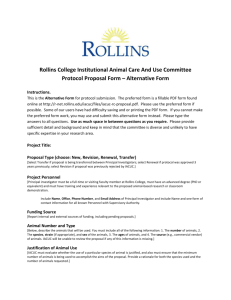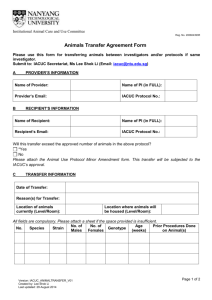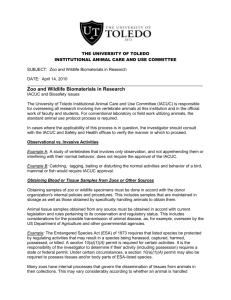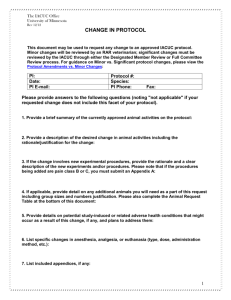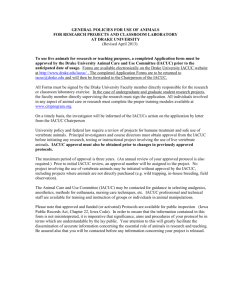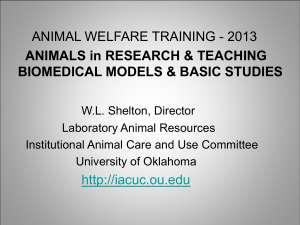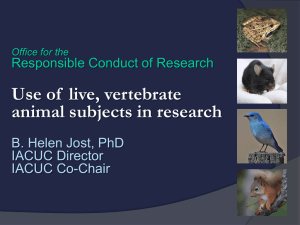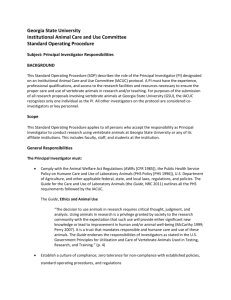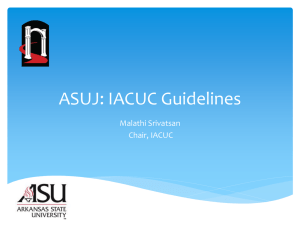Improving Protocol Review and Approval Efficiency
advertisement
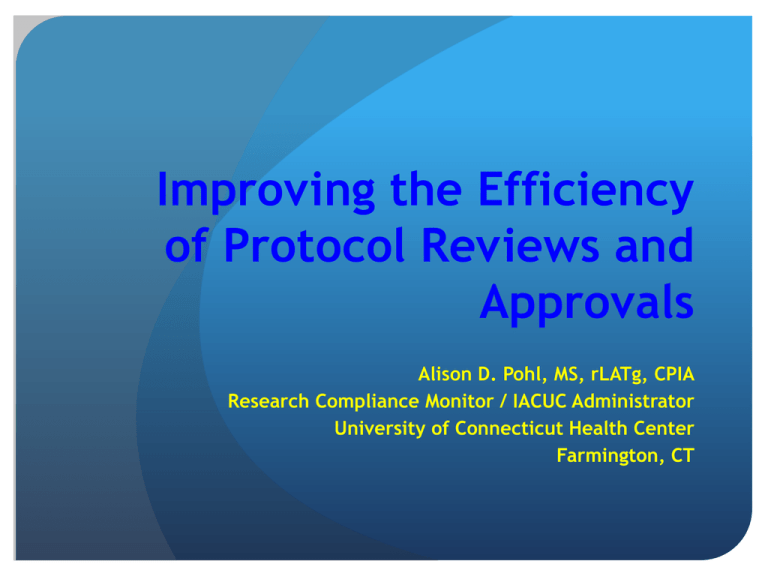
Improving the Efficiency of Protocol Reviews and Approvals Alison D. Pohl, MS, rLATg, CPIA Research Compliance Monitor / IACUC Administrator University of Connecticut Health Center Farmington, CT What is “improving” protocol review? From the PI’s perspective: Only one review (e.g., no “back and forth” revisions) Focus on the “important stuff”, not the small details Make it as easy on me as possible From the IACUC’s perspective: Catch everything that is important (one review may not be enough) Make it as easy as possible for the IACUC Try to make it as easy as possible for the PI What is “improving” approval efficiency? From the PI’s perspective: Get my approval as fast as possible (preferably yesterday) From the IACUC’s perspective: Get the approval done as fast as possible (though yesterday is probably not possible) Seems like there is a shared goal here?? What can the PI do to improve the efficiency of a review? Submit a thoughtful and complete protocol that tells the whole story Make sure all questions are answered Make sure the answers to the questions are actually answers to the questions; in other words, don’t answer the question with incomplete or incorrect information Submit protocols by established deadlines Submit protocols for a pre-review if that activity is performed by an institution When submitting revisions after IACUC review Make sure all comments are addressed What can the IACUC do to improve the efficiency of a review? Perform pre-reviews Can be done by the IACUC administrator to a great degree Veterinary pre-review can be very important Ensure IACUC members know what constitutes an appropriate review Reviews should be consistent between protocols and IACUC members Training, training, training! Have the IACUC invested in the research of the institution Complete reviews by an assigned deadline Do your review as if you were the PI (be kind) Utilize DMR when you can One way to improve efficiency is…. Go Electronic Can help you make the whole protocol review and approval process faster, more thorough, and more consistent Does not mean just using an electronic protocol development and review system (either commercial or home-grown) Electronic methodologies can mean more version control, less chance of losing vital information, and increased access to information for both the PI and the IACUC And you have the added benefit of “being green” Non-system electronic methods Shared electronic drives (through your IT department) All IACUC members can access all information Information access is restricted to those members who have been “allowed” access Typically backed up by the Institution so that data loss is unlikely Electronic signatures (e.g., use of Adobe Acrobat) Takes less time because you do not have to physically go to someone’s office for a signature Accepted by most agencies (OLAW, USDA, NIH, etc.) Web-based sign up services (e.g., Signupgenius.com) Can be used for facility inspections and meetings Non-system electronic methods Programs for facility inspections (e.g., InvisoSystems) There are programs out there that you can use with an iPad or smart phone to document real-time documentation of facility and laboratory inspections They can allow for the automatic compilations of deficiencies into a report that can be emailed to the appropriate responsible individuals Programs for documenting review changes (e.g., SharePoint, PleaseReview) Though use of a shared drive can also get people to see the same documents, typically only one person can make changes at a time There are programs which can automatically track changes which, at the end of the review period, can incorporate the changes into a nicely formatted document Electronic protocol development and review systems Can be commercial or home-grown Advantages Complete historical record of the submissions/reviews PI can see where in the process his submission is Version control Electronic signatures Auto-population of demographic information Pull down menus with appropriate answers Templates for common procedures Electronic protocol development and review systems Disadvantages Change- and this can be a significant problem depending on your institution More technical process that typically requires more training for everyone involved More structure and less flexibility More complex Periodic upgrades can create lost data Administration is typically more labor intensive (translation: MORE WORK FOR THE ADMINISTRATOR) If your system is web-based, and you lose web access, all work can be lost permanently Cost- system, maintenance, license(s), etc. If you decide to go with an electronic system: BE PREPARED. It is often a case of two steps forward, one step back Establish a selection committee composed of IACUC administrator, member, PIs, safety, IT, etc. to represent various end users Get references from current users. This can be difficult if your institution has strict criteria for references Do not under-estimate the need for training by IACUC administrators, IACUC reviewers, and PIs What we learned when implementing a commercial system: Need a strong relationship with your vendor Need a champion in senior management of your institution Listen to your vendor’s recommendations, but realize that what they might be telling you might not be fully accurate (positive spin) Negotiate your contract CAREFULLY Patience really IS a virtue; glitches will happen and the process will take longer than you think Expect lack of participation from key stakeholders Lack of depth needs to be avoided Resistance from end-users should be expected Again, training is key for success Acknowledgements I would like to gratefully acknowledge the following individuals for their help and expertise: Marcy Brown, MA, CPIA Regulatory Compliance Pfizer, Worldwide Research & Development Stacy Pritt, DVM, MBA, CPIA, DACAW Director, IACUC UT Southwestern Medical Center

